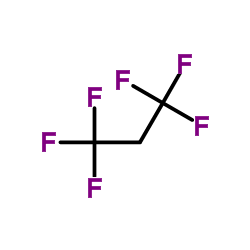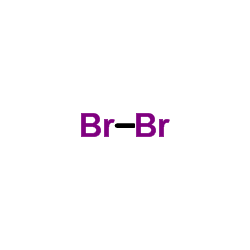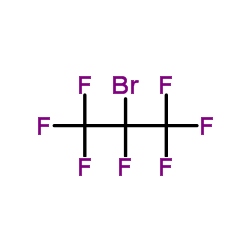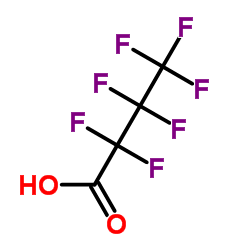661-95-0
| 中文名 | 1,2-二溴六氟丙烷 |
|---|---|
| 英文名 | 1,2-dibromohexafluoropropane |
| 英文别名 |
Propane,1,2-dibromo-1,1,2,3,3,3-hexafluoro
EINECS 211-550-8 rac-1,2-Dibromohexafluoropropane 1,2-dibromo-1,1,2,3,3,3-hexafluoro-propane MFCD00013568 1,1,1,2,3,3-Hexafluoro-2,3-dibromopropane 1,2-Dibrom-hexafluor-propan 1,2-dibromo-1,1,2,3,3,3-hexafluoro-propan 1,2-dibromo-hexafluoro-propane |
| 密度 | 2.169 |
|---|---|
| 沸点 | 73 °C |
| 熔点 | -95 °C |
| 分子式 | C3Br2F6 |
| 分子量 | 309.83100 |
| 闪点 | 71-72°C |
| 精确质量 | 307.82700 |
| LogP | 3.59710 |
| 外观性状 | 无色液体 |
| 折射率 | 1.3605 |
| 储存条件 | 存放在密封容器内,并放在阴凉,干燥处。储存的地方必须远离氧化剂。 |
| 稳定性 | 远离氧化物。 |
| 分子结构 | 1、 摩尔折射率:32.29 2、 摩尔体积(m3/mol):137.2 3、 等张比容(90.2K):298.1 4、 表面张力(dyne/cm):22.2 5、 介电常数: 6、 偶极距(10 -24cm 3): 7、 极化率:12.80 |
| 计算化学 | 1.疏水参数计算参考值(XlogP):4 2.氢键供体数量:0 3.氢键受体数量:6 4.可旋转化学键数量:1 5.互变异构体数量:无 6.拓扑分子极性表面积0 7.重原子数量:11 8.表面电荷:0 9.复杂度:152 10.同位素原子数量:0 11.确定原子立构中心数量:0 12.不确定原子立构中心数量:1 13.确定化学键立构中心数量:0 14.不确定化学键立构中心数量:0 15.共价键单元数量:1 |
| 更多 | 1. 性状:无色液体。 2. 密度(g/mL,25/4℃):2.169 3. 相对蒸汽密度(g/mL,空气=1):未确定 4. 熔点(ºC):-95 5. 沸点(ºC,常压):71-72 6. 沸点(ºC,5.2kPa):未确定 7. 折射率:1.3605 8. 闪点(ºC):71-72 9. 比旋光度(º):未确定 10. 自燃点或引燃温度(ºC):未确定 11. 蒸气压(kPa,25ºC):未确定 12. 饱和蒸气压(kPa,60ºC):未确定 13. 燃烧热(KJ/mol):未确定 14. 临界温度(ºC):未确定 15. 临界压力(KPa):未确定 16. 油水(辛醇/水)分配系数的对数值:未确定 17. 爆炸上限(%,V/V):未确定 18. 爆炸下限(%,V/V):未确定 19. 溶解性:未确定 。 |
Synonym: Section 2 - COMPOSITION, INFORMATION ON INGREDIENTS
Risk Phrases: 20/21/22 36/37/38 Section 3 - HAZARDS IDENTIFICATION EMERGENCY OVERVIEW
Harmful by inhalation, in contact with skin and if swallowed. Irritating to eyes, respiratory system and skin. Potential Health Effects Eye: Causes eye irritation. May cause chemical conjunctivitis. Skin: Causes skin irritation. Ingestion: May cause gastrointestinal irritation with nausea, vomiting and diarrhea. Inhalation: Causes respiratory tract irritation. Can produce delayed pulmonary edema. Chronic: Effects may be delayed. Section 4 - FIRST AID MEASURES Eyes: Immediately flush eyes with plenty of water for at least 15 minutes, occasionally lifting the upper and lower eyelids. Get medical aid. Skin: Get medical aid. Flush skin with plenty of water for at least 15 minutes while removing contaminated clothing and shoes. Wash clothing before reuse. Ingestion: Never give anything by mouth to an unconscious person. Get medical aid. Do NOT induce vomiting. If conscious and alert, rinse mouth and drink 2-4 cupfuls of milk or water. Wash mouth out with water. Inhalation: Remove from exposure and move to fresh air immediately. If not breathing, give artificial respiration. If breathing is difficult, give oxygen. Get medical aid. Do NOT use mouth-to-mouth resuscitation. Notes to Physician: Treat symptomatically and supportively. Section 5 - FIRE FIGHTING MEASURES General Information: As in any fire, wear a self-contained breathing apparatus in pressure-demand, MSHA/NIOSH (approved or equivalent), and full protective gear. During a fire, irritating and highly toxic gases may be generated by thermal decomposition or combustion. Vapors may be heavier than air. They can spread along the ground and collect in low or confined areas. Runoff from fire control or dilution water may cause pollution. Extinguishing Media: Use water spray, dry chemical, carbon dioxide, or chemical foam. Section 6 - ACCIDENTAL RELEASE MEASURES General Information: Use proper personal protective equipment as indicated in Section 8. Spills/Leaks: Absorb spill with inert material (e.g. vermiculite, sand or earth), then place in suitable container. Avoid runoff into storm sewers and ditches which lead to waterways. Clean up spills immediately, observing precautions in the Protective Equipment section. Provide ventilation. Section 7 - HANDLING and STORAGE Handling: Avoid breathing dust, vapor, mist, or gas. Avoid contact with eyes, skin, and clothing. Keep container tightly closed. Avoid ingestion and inhalation. Use with adequate ventilation. Wash clothing before reuse. Storage: Store in a tightly closed container. Store in a cool, dry, well-ventilated area away from incompatible substances. Section 8 - EXPOSURE CONTROLS, PERSONAL PROTECTION Engineering Controls: Facilities storing or utilizing this material should be equipped with an eyewash facility and a safety shower. Use adequate ventilation to keep airborne concentrations low. Exposure Limits CAS# 661-95-0: Personal Protective Equipment Eyes: Wear appropriate protective eyeglasses or chemical safety goggles as described by OSHA's eye and face protection regulations in 29 CFR 1910.133 or European Standard EN166. Skin: Wear appropriate protective gloves to prevent skin exposure. Clothing: Wear appropriate protective clothing to prevent skin exposure. Respirators: Follow the OSHA respirator regulations found in 29 CFR 1910.134 or European Standard EN 149. Use a NIOSH/MSHA or European Standard EN 149 approved respirator if exposure limits are exceeded or if irritation or other symptoms are experienced. Section 9 - PHYSICAL AND CHEMICAL PROPERTIES Physical State: Clear liquid Color: colorless Odor: Not available. pH: Not available. Vapor Pressure: Not available. Viscosity: Not available. Boiling Point: 70 - 72 deg C @ 734 Freezing/Melting Point: -95 deg C Autoignition Temperature: Not available. Flash Point: Not available. Explosion Limits, lower: Not available. Explosion Limits, upper: Not available. Decomposition Temperature: Solubility in water: Specific Gravity/Density: 2.1690g/cm3 Molecular Formula: CF3CF(Br)CF2Br Molecular Weight: 309.85 Section 10 - STABILITY AND REACTIVITY Chemical Stability: Stable at room temperature in closed containers under normal storage and handling conditions. Conditions to Avoid: Incompatible materials, excess heat. Incompatibilities with Other Materials: Oxidizing agents. Hazardous Decomposition Products: Carbon monoxide, carbon dioxide, hydrogen fluoride gas, hydrogen bromide. Hazardous Polymerization: Has not been reported Section 11 - TOXICOLOGICAL INFORMATION RTECS#: CAS# 661-95-0: TX8800000 LD50/LC50: Not available. Carcinogenicity: (+/-)-1,2-Dibromohexafluoropropane - Not listed by ACGIH, IARC, or NTP. Other: See actual entry in RTECS for complete information. Section 12 - ECOLOGICAL INFORMATION Section 13 - DISPOSAL CONSIDERATIONS Dispose of in a manner consistent with federal, state, and local regulations. Section 14 - TRANSPORT INFORMATION IATA Shipping Name: Not regulated. Hazard Class: UN Number: Packing Group: IMO Shipping Name: Not regulated. Hazard Class: UN Number: Packing Group: RID/ADR Shipping Name: Not regulated. Hazard Class: UN Number: Packing group: Section 15 - REGULATORY INFORMATION European/International Regulations European Labeling in Accordance with EC Directives Hazard Symbols: XN Risk Phrases: R 20/21/22 Harmful by inhalation, in contact with skin and if swallowed. R 36/37/38 Irritating to eyes, respiratory system and skin. Safety Phrases: S 26 In case of contact with eyes, rinse immediately with plenty of water and seek medical advice. S 36/37/39 Wear suitable protective clothing, gloves and eye/face protection. WGK (Water Danger/Protection) CAS# 661-95-0: No information available. Canada CAS# 661-95-0 is listed on Canada's NDSL List. CAS# 661-95-0 is not listed on Canada's Ingredient Disclosure List. US FEDERAL TSCA CAS# 661-95-0 is listed on the TSCA inventory. SECTION 16 - ADDITIONAL INFORMATION N/A |
|
毒理学数据: 1、急性毒性:兔子(口服)LDLo: 8,624 mg/kg 由于食盐的LD50是3,000 mg/kg,BPA的急性毒性程度与食盐同。 生态学数据: 对水稍微有危害的,不要让未稀释或者大量产品接触地下水,水道或者污水系统。若无政府许可,勿将材料排入周围环境。 CHEMICAL IDENTIFICATION
HEALTH HAZARD DATAACUTE TOXICITY DATA
|
| 危害码 (欧洲) | Xi: Irritant; |
|---|---|
| 风险声明 (欧洲) | R20/21/22 |
| 安全声明 (欧洲) | S26-S36/37/39 |
| RTECS号 | TX8800000 |
|
~96% 
661-95-0 |
| 文献:Bayer Chemicals AG Patent: EP1418171 A1, 2004 ; Location in patent: Page 10 ; |
|
~% 
661-95-0 |
| 文献:Journal of the American Chemical Society, , vol. 68, p. 968 |
|
~0% 
661-95-0
详细
|
| 文献:Katsuhara, Yutaka; DesMarteau, Darryl D. Journal of Organic Chemistry, 1980 , vol. 45, # 12 p. 2441 - 2446 |
|
~% 
661-95-0 |
| 文献:Journal of the American Chemical Society, , vol. 68, p. 968 |
|
~% 
661-95-0
详细
|
| 文献:Bulletin of the Academy of Sciences of the USSR, Division of Chemical Science (English Translation), , vol. 34, # 10 p. 2128 - 2131 Izvestiya Akademii Nauk SSSR, Seriya Khimicheskaya, , # 10 p. 2298 - 2302 |
|
~% 
661-95-0
详细
|
| 文献:Journal of Physical Chemistry, , vol. 91, # 16 p. 4278 - 4284 |
|
~% 
661-95-0 |
| 文献:Journal of the Chemical Society, , p. 4259,4266 Journal of the Chemical Society, , p. 3761,3767 |
|
~% 
661-95-0 |
| 文献:US2404374 , ; |















